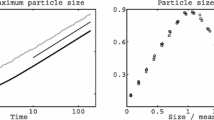Abstract:
We study slowly moving solutions of the real Ginzburg–Landau equation on the infinite line, by a method inspired by the work of J. Carr and R. L. Pego. These solutions are functions taking alternately positive or negative values on large intervals. We give a formula for the speed of the motion of the zeros of these functions and present a description of the collapse of two nearby zeros. Since we work on an infinite domain, we can find initial conditions which lead to infinite sequences of collapses of kinks. These results justify in part the approach to the coarsening problem by a simplified model proposed by A. J. Bray, B. Derrida, and C. Godrèche. Their model starts from a random distribution of domain lengths and evolves by successive elimination of the smallest domain. Our model is on one hand more realistic, since it controls the original Ginzburg–Landau equation in continuous time. On the other hand, we fail to gain sufficient control over the vanishing of pairs of kinks “embedded” within pairs of kinks at a greater distance.
Similar content being viewed by others
Author information
Authors and Affiliations
Additional information
Received: 26 June 1997 / Accepted: 18 May 1998
Rights and permissions
About this article
Cite this article
Eckmann, JP., Rougemont, J. Coarsening by Ginzburg–Landau Dynamics. Comm Math Phys 199, 441–470 (1998). https://doi.org/10.1007/s002200050508
Issue Date:
DOI: https://doi.org/10.1007/s002200050508




